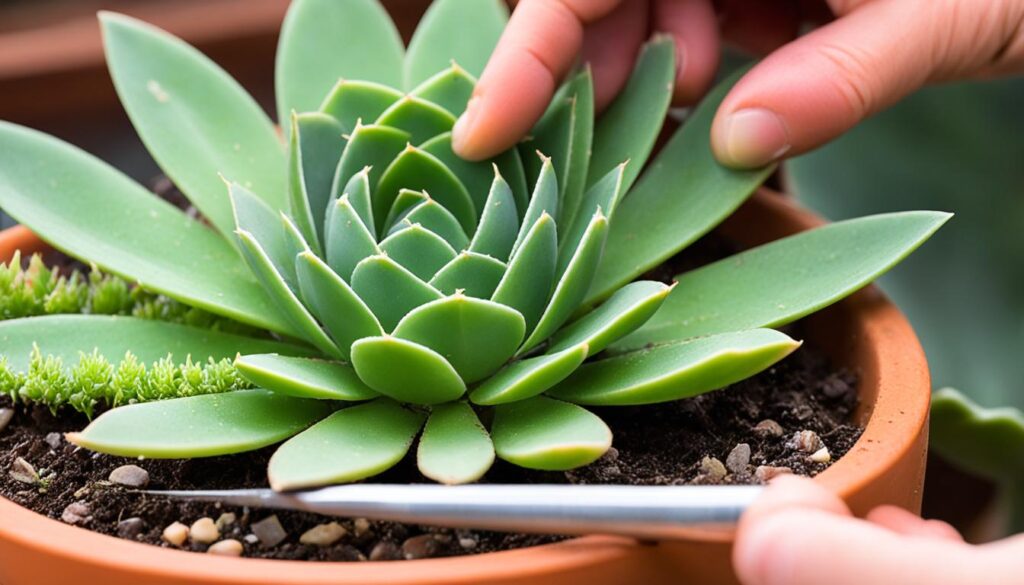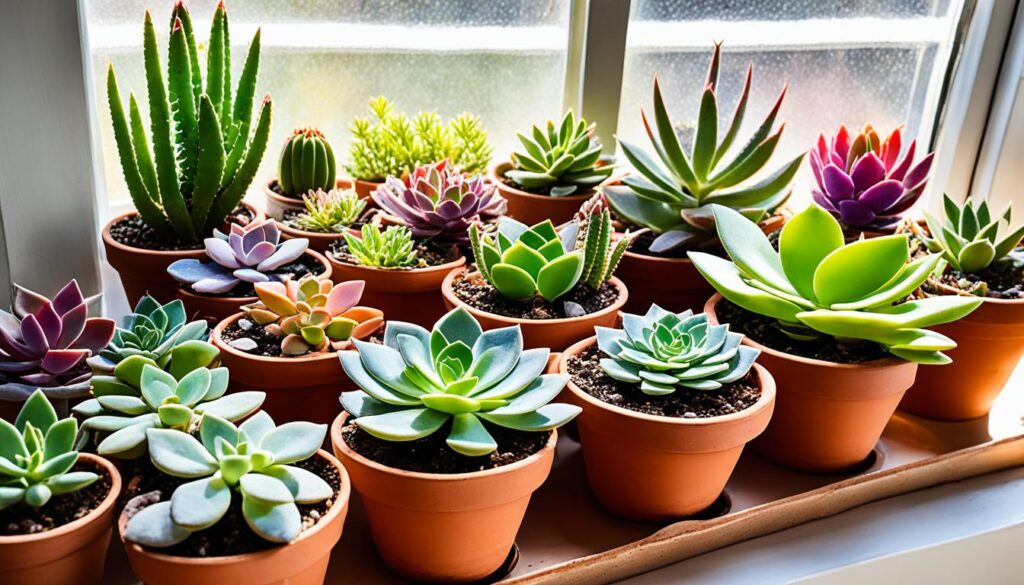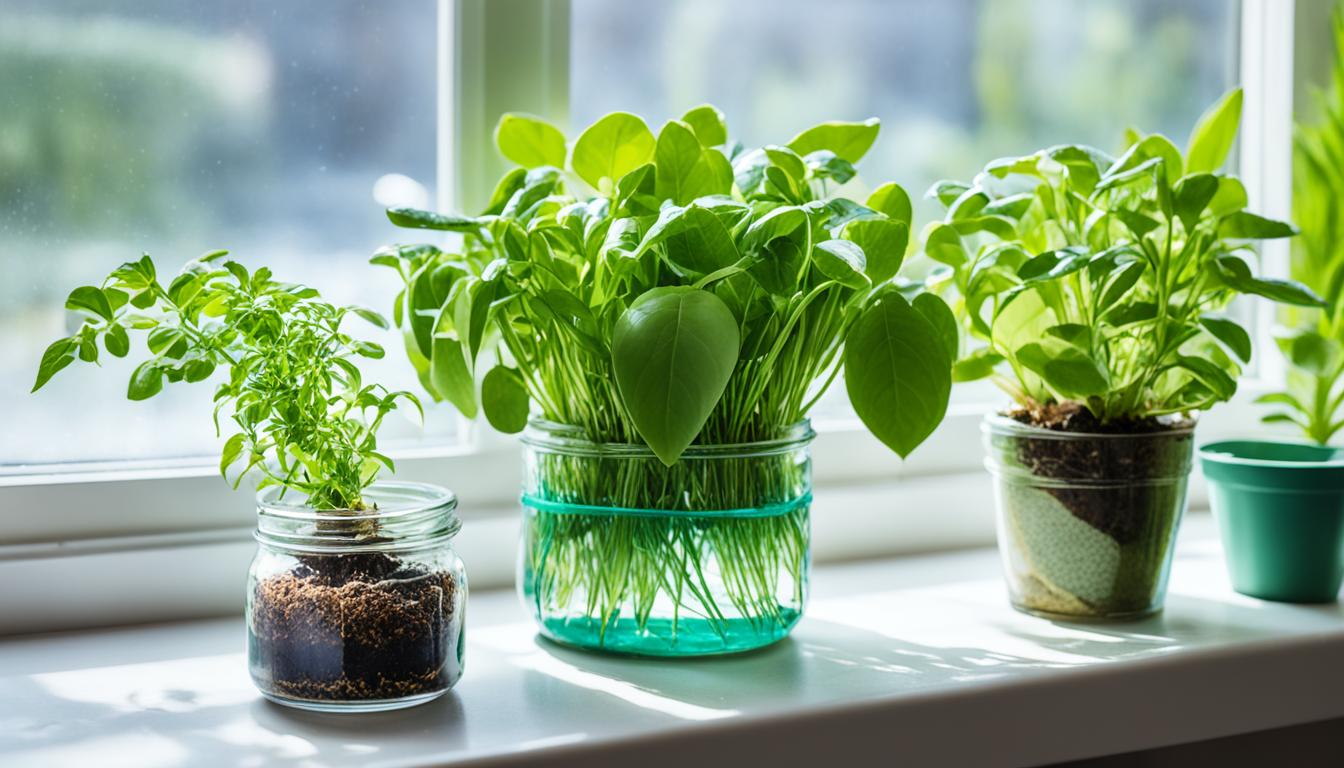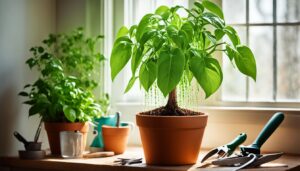Do you have a beloved houseplant you wish you could multiply? The secret to expanding your indoor jungle lies in the art of plant propagation. This process lets you make new plants from your current ones. It fills your home with lush foliage and vibrant blooms you love.
In this guide, you’ll learn exciting methods for propagating your favorite indoor plants. You’ll discover how to divide and root leaf cuttings, and how to root stem cuttings in water or soil. By the end, you’ll be able to confidently grow your houseplants and watch them thrive.
Are you ready to learn the secrets to successfully propagating your indoor plants? Let’s dive in and explore the world of plant multiplication!
Introduction to Indoor Plant Propagation
Houseplant propagation is a fun and rewarding journey for plant lovers. It lets you make new plants from your current ones, without spending more money. This way, you can grow your plant collection or share plants with friends and family.
Watching a new plant grow from a cutting or division is amazing. You see the plant’s life cycle and how it reproduces. It’s a magical process.
The Excitement of Creating New Plants
Propagating your indoor plants is exciting, whether you’re new or experienced. You get to see a cutting or division turn into a strong, new plant. It’s a great way to connect with nature and feel proud of your work.
By propagating your plants, you open up new possibilities. You can add more variety to your plants, create unique displays, or even start a small nursery. The joy of growing more plants is something every plant enthusiast should try.
“The process of propagating plants is truly fascinating, as you get to witness the natural cycle of growth and reproduction.”
Plant Propagation Methods
Expanding your indoor plant collection is exciting and rewarding with plant propagation methods. You can create new plants from your existing ones. Techniques like dividing houseplants, propagating from leaf cuttings, and rooting stem cuttings are available. Each method has its own benefits, helping you choose the best for your plants.
Dividing Houseplants
Dividing is great for plants that produce offsets, like spider plants and sansevierias. By separating the plant into smaller sections, you can quickly grow more plants. This is often the easiest way to multiply these plants.
Propagating from Leaf Cuttings
Many indoor plants, including begonias and African violets, can be grown from leaf cuttings. You take a healthy leaf and a bit of stem, then root it in soil or water. Once it grows roots, you can move it to a pot and care for it as a new plant.
| Propagation Method | Best Suited Plants | Advantages |
|---|---|---|
| Dividing Houseplants | Spider plants, sansevierias | Quick and easy propagation, often the most efficient method for these types of plants |
| Propagating from Leaf Cuttings | Begonias, African violets | Allows you to create new plants from a single leaf, works well for a variety of houseplants |
| Rooting Stem Cuttings | Succulents, philodendrons, pothos | Versatile method that can be used for a wide range of indoor plants, allows for easy propagation |
Knowing the different plant propagation methods and their benefits is key to growing your indoor plants. Mastering these techniques lets you make new, healthy plants from your favorites.
Dividing Houseplants
Dividing your houseplants is a great way to make more plants and grow your indoor garden. It’s also a nice way to share plants with friends. Learning how to divide houseplants is easy and fun.
Steps for Dividing Plants
The best time to divide houseplants is in the spring when they grow the most. Here are the steps to divide your plants:
- Gently remove the plant from its pot and look at the roots. Find sections with strong roots and leaves.
- Use a sharp, clean knife or pruners to cut the plant into two or more parts. Make sure each part has roots and leaves.
- Put the divided parts into new pots filled with good potting soil. Plant them at the same depth as before.
- Water the new plants well and put them in a warm spot with soft light.
- Watch the plants closely and take care of them. This includes watering, feeding, and controlling pests to help them grow.
With a little care, your dividing houseplants will get used to their new homes and grow new leaves. Enjoy the happiness of plant division and propagating by division. It’s a great way to grow your garden and share your love for plants.
Propagating from Leaf Cuttings
Propagating your favorite indoor plants from leaf cuttings is a joy. It’s a simple way to make new plants, especially for succulents and other leafy plants. By learning how to propagate from leaf cuttings, you can grow a beautiful indoor garden. You can also share your plants with friends and family.
To successfully propagate from leaf cuttings, you need patience and care. Start by picking a healthy, mature leaf from your plant. Cut the leaf at its base, leaving a bit of stem attached. Let the cutting dry out for a few days to form a protective layer.
After drying, it’s time to plant the cutting. Using a rooting hormone can help roots grow and boost your chances of success. Put the cutting in a potting mix that drains well, making sure the leaf stands upright and the stem is covered. Sansevierias, jade plants, and ZZ plants work well for this method.
With patience and the right care, your cutting will grow roots and new leaves. Keep it in bright, indirect light and keep the soil moist but not too wet. In a few weeks, you’ll see your cutting grow into a strong, new plant.
Propagating from leaf cuttings is a great way to grow your indoor plants without spending a lot. It uses the power of leaves to create a garden that shows your style and care for the environment.
“Propagating plants from leaf cuttings is like witnessing the miracle of life unfold before your eyes. It’s a truly captivating process that connects you to the natural world in a profound way.”

| Plant Type | Ease of Propagation from Leaf Cuttings |
|---|---|
| Succulents | Very Easy |
| Sansevierias | Easy |
| Jade Plants | Moderate |
| ZZ Plants | Easy |
how to propagate indoor plants
Rooting Stem Cuttings in Water or Soil
Propagating indoor plants from stem cuttings is a great way to grow more of your favorite plants. You can root stem cuttings in water or soil, depending on what you prefer and what your plants need.
When taking a stem cutting, cut just below a node. This is where the new roots will emerge. Using a rooting hormone can also help roots grow faster.
To propagate in water, put the cutting in a container of water. Wait for the roots to grow about 1 inch long. Then, move the cutting to a pot with good drainage.
You can also root plant cuttings directly in soil. Put the cutting in a pot with the right soil, making sure most of the stem is covered. Keep the soil moist and the cutting in a bright, warm spot until you see new leaves.
Some plants that propagate well from stem cuttings are pothos, Chinese evergreen, dracaena, and philodendron. Try different plants and enjoy the fun of propagating indoor plants from cuttings.
Caring for Propagated Plants
Congratulations! You’ve successfully propagated your favorite indoor plants. Now, it’s time to give them the right care for growth and success. It’s important to know the light requirements, water needs, and fertilizer requirements of your new plants.
Light Requirements for Propagated Plants
The light needs of your plants depend on the type. Generally, young plants should be in bright, indirect light. Direct sunlight can be too strong and harm them. Watch how your plants react to their light and adjust it as needed.
Water Requirements for Propagated Plants
- Keep the soil moist, especially when they’re young.
- Don’t let the soil dry out, as it can stress the plant.
- Water your plants often, but don’t overdo it to avoid harm.
Fertilizer for Propagated Plants
Give your plants a balanced, diluted liquid fertilizer for nutrients. Start with a weak solution and increase it as they grow. Watch how they react to the fertilizer and adjust it if needed for their best nutrition.
By paying attention to the light, water, and fertilizer requirements of your propagated plants, you’ll help them grow strong. They’ll become beautiful additions to your indoor plants.

Troubleshooting Propagation Issues
Propagating indoor plants can be rewarding but also challenging. You might face issues like cuttings not rooting or leaves and stems rotting. With troubleshooting and adaptation, you can overcome these problems and grow new plants from your houseplants.
One common issue is cuttings not developing roots. This could be from improper cuts, low humidity, or the cutting not forming strong roots. To fix this, make clean cuts, use rooting hormone, and keep the humidity high with a propagation tray or plastic bag.
Rot is another issue, where leaves or stems decay. It’s often from too much water or bad soil. To avoid rot, watch your watering and make sure the soil drains well. If you see rot, cut off the bad parts and change your care habits.
After propagating, your plants might not do well in their new home. This could be from not enough light, bad fertilizing, or adjusting to the new environment. To solve this, keep an eye on your plants, give them the right light and nutrients, and help them get used to their new spot slowly.
With patience, observation, and trying new things, you can grow a collection of new plants from your houseplants. Every successful propagation shows your green thumb and nature’s resilience.
- Cuttings not rooting
- Leaves or stems rotting
- Propagated plants failing to thrive after transplanting
“With a bit of troubleshooting and a willingness to adapt, you can overcome most propagation obstacles and successfully grow new plants from your existing houseplants.”
Conclusion
Propagating your indoor plants is rewarding and saves money. You can grow more of your favorite plants using techniques like division, leaf cuttings, and stem cuttings. This way, you can share plants with friends, family, and other plant lovers.
Each plant needs different amounts of light, water, and nutrients. So, make sure to meet the needs of your new plants. With practice and patience, you’ll become an expert in growing houseplants.
The journey of indoor plant propagation is exciting. It’s fulfilling to see new plants grow from your old ones. Keep improving your skills in indoor plant propagation. Watch your collection of indoor plants grow and thrive.
FAQ
What are the most common methods for propagating indoor plants?
Common ways to spread indoor plants include dividing the plant, using leaf cuttings, and stem cuttings in water or soil.
When is the best time to divide houseplants for propagation?
Spring is the best time to split houseplants for spreading. This is when they grow the most.
What types of plants can be propagated from leaf cuttings?
You can grow sansevierias, jade plants, and ZZ plants from leaf cuttings.
How do you properly take and root stem cuttings for propagation?
To take a stem cutting, cut just below a node, where roots will start. Using a rooting hormone can boost root growth. Then, you can put the cuttings in water or soil to root.
What are some common challenges with indoor plant propagation?
Issues like cuttings not rooting, rotting, or not thriving after moving can happen. These problems might come from bad cutting methods, not enough humidity, too much water, or poor soil.





